| Bedolla |
Bocchini | Boyd | Brew | Dalton |
| Flanagan | Hackendorn | Hoffmann | Jalan | McGraw |
| Myrick | Quigley | Reinicker | Sargianis | Steelman |
| Stengel | Wells | Woods | Zagrobelny |
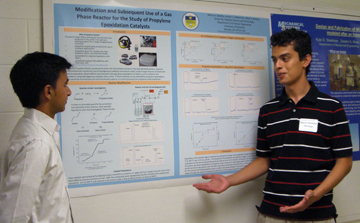 Modification and Subsequent Use of a Gas Phase Reactor for the Study of Propylene Epoxidation Catalysts Marco A. Bedolla, Joseph C. Dellamorte, Mark A. Barteau Department of Chemical Engineering Recent work has shown the
presence of an oxametallacycle on Ag
catalysts for ethylene epoxidation. This work led to the prediction
that the addition of Cu to the catalyst would improve the selectivity
to the desired product ethylene oxide. A similar reaction involves the
epoxidation of propylene to propylene oxide. In order to study
catalysts for this system in a similar fashion to ethylene, the reactor
and gas chromatograph were reconfigured. First, possible products from
the reaction were researched and the method used for the gas
chromatograph was reformulated to separate all reactant and product
species from the outlet stream.
Preliminary studies of the gas phase reaction were undertaken with
silver catalysts supported on -Al2O3 monoliths
and doped with either
copper or cesium. It was shown that the conversion of propylene to
propylene oxide and other products (CO2) was greater for the
Cs-Ag
catalyst than for the Cu-Ag catalyst. With the Cs-Ag catalyst, the
inlet stream to the reactor contained 10% v/v each of propylene and
oxygen in nitrogen; however, the Cu-Ag catalyst required much greater
oxygen concentrations to be effective (40% v/v O2). It was
also
observed that the Cs-Ag catalyst produced a still unidentified side
product in addition to PO and CO2. The effects of the
partial pressure
of O2 with the Cs-Ag catalyst were also studied. As the
partial
pressure of oxygen increased, the activity of the catalyst increased
along with the production of PO relative to the other products.
|
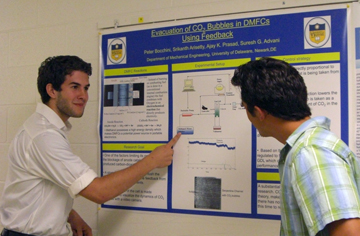 Strategy for Managing the Negative Effects of Carbon-Dioxide Evolution in Direct Methanol Fuel Cells Peter Bocchini, Srikanth Arisetty, Ajay K. Prasad, and Suresh G. Advani Department of Mechanical Engineering Direct methanol fuel cells are
considered to be a potential power
source for use in portable applications. One of the factors limiting
their performance is the blockage of anode catalyst sites by produced
carbon-dioxide (CO2) bubbles. In this study we will develop a strategy
to flush the stagnant CO2 bubbles with the feedback from pressure drop
measurements. The anode side of the cell is made transparent so that we
can visualize the dynamics of CO2 bubbles with a video camera.
Experiments will be repeated with parallel, serpentine, and
interdigitated flow fields. Gas production will also be measured at
different current densities as well as different flow rates.
|
|
Analyzing Word Usage in Software to Improve Software Maintenance Tools Haley Boyd, Lori Pollock, Emily Hill, and K. Vijay-Shanker Department of Computer and Information Science Currently, many software
systems are large and complex. Maintaining these software systems
requires that programmers comprehend scattered pieces of code that are
often produced by more than one developer. Programmers
comprehend code
by identifying code segments that are relevant to their particular
maintenance task, comprehending the relevant code, and then making
modifications to perform the maintenance task. We hypothesize that
software maintainers use both the programmers' words, which we call
textual clues, and the knowledge of programming language structures,
which we call program structure, to identify and understand relevant
code segments. Â This work focuses on analyzing a large set
of real
maintenance requests and the corresponding code segments that were
changed, with the goal of learning what kinds of textual and structural
clues programmers use in the identification and understanding phases of
software maintenance. Particularly, my work this summer involved
gathering and analyzing large open-source software projects made
available by SourceForge, with the goal of learning by examples.
 I
automated the process of retrieving the commit messages for each
maintenance request from each project's configuration management
system's log files. Â I manually analyzed the words and
program
structure involved in the commit messages and maintenance request text,
taking note of any clues that might teach us how the programmer would
identify the relevant code segments for a given maintenance request.
 The information that we learn from this study will be used
to develop
heuristics to automate the tedious, error-prone tasks and optimize
software maintenance tools for reliable software systems as they evolve
over time with new features and fixed bugs.
|
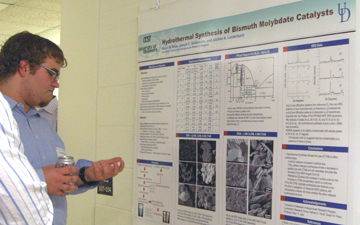 Hydrothermal Synthesis of Bismuth Molybdate Catalysts Kevin W. Brew, Joseph C. Dellamorte, and Jochen A. Lauterbach Department of Chemical Engineering Bismuth molybdates of the
general chemical formula Bi2O3.nMoO3, n = 3,
2, 1, and their metal-ion-doped analogues, have catalytic applications
on selective oxidation, oxidative-dehydrogenation, and ammoxidation of
lower olefins, as well as unique physical properties with potential
technological application as ionic conductors, acousto-optical
materials, photoconductors, gas sensors and visible-light responsive
photocatalysts. Hydrothermal synthesis is the technique of
crystallizing substances from high-temperature aqueous solutions at
high vapor pressures. The advantage of hydrothermal synthesis over
conventional precipitation and calcination methods is that compounds
such as surfactants that may decompose at elevated temperatures can be
used to control the crystal size, shape and phase because operating
temperatures are below 200 °C. To investigate the effect of the
crystal
morphology on the catalytic performance, several bismuth molybdate
catalysts were synthesized hydrothermally, focusing on three phases:
alpha – Bi2Mo3O12, beta– Bi2Mo2O9, gamma – Bi2MoO6. After adjusting the
pH of the mixture solution of precursors, the mixture solution was
transferred into a reaction vessel and maintained at 413K for 48 hours.
A surfactant was introduced to the synthesis process at concentrations
of 0.25, 0.5 M. The products were filtered off, washed several times
with distilled water and absolute ethanol. Each sample was calcined
after hydrothermal synthesis. To ensure formation of pure catalyst
phases, samples were analyzed with XRD. Each sample was analyzed with
SEM to obtain catalyst morphology as well as a particle size
distribution. The SEM images show the crystal size changes with
increasing the concentrations of surfactant. Funded by the University
of Delaware’s Undergraduate Research Program.
|
 Hurricane Evacuation in Delaware Sarah Dalton, Sue McNeil, Rachel Davidson, and Earl Rusty Lee Department of Civil and Environmental Engineering, Disaster Research Center Delaware is located on the
Delmarva Peninsula, bordered on the east by the Atlantic Ocean and on
the west by the Chesapeake Bay. Because of this location Delaware is a
state vulnerable to many natural hazards. Sussex County, the
southernmost county in Delaware, is at risk for seventeen of the
twenty-one hazards defined by the federal government, the most
threatening of these being floods and hurricanes. Although hurricanes
do not pass through this area often, they do occasionally, and the
state is in a very vulnerable position when it happens. Evacuation
plans exist, but with limited experience we do not know how effective
or efficient these plans are. This research hopes to determine if
Delaware's pre-existing evacuation plans are adequate and up to current
practices if a mass evacuation were to be ordered in the state. To do
thi! ! s, a state of the art and practice review was completed by
reviewing evacuation plans from both hurricane prone states and non
hurricane prone states. A review was also done on engineering and
sociological literature relating to evacuations to bridge the gap
between the two disciplines. Finally, the research examined the gaps
between Delaware's plans, model, assumptions, etc. and the
aforementioned research.
|
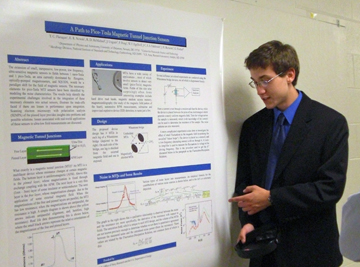 T. C. Flanagan1, E. R. Nowak1, R. D. McMichael2, J. Unguris2, P. Pong3, and W. F. Egelhoff, Jr3. 1UD Department of Physics and Astronomy, 2Center for Nanoscale Science and Technology, 3Metallurgy Division, National Institute of Standards and Technology The extension of small,
inexpensive, low-power, low frequency, ultra-sensitive magnetic sensors
to fields between 1 nano-Tesla and 1 pico-Tesla, an area currently
dominated by fluxgates, optically-pumped magnetometers, and SQUIDS,
would be a paradigm shift for the field of magnetic sensors. The
necessary elements for pico-Tesla MTJ sensors have been identified by
modeling the noise characteristics. The results help identify the
experimental challenges involved in the integration of these necessary
elements into actual sensors and illustrate the trade-offs faced if
there are losses in performance upon integration. Scanning electron
microscopy with polarization analysis (SEMPA) of the pinned layer
provides insights into problems and possible solutions. Issues
associated with real-world applications of these sensors to ultra-low
field measurements are discussed.
|
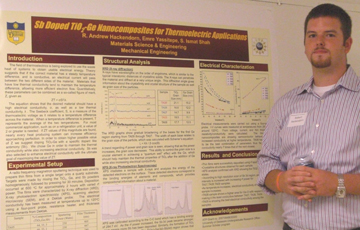 Sb Doped Ti02-Ge Nanocomposites for Thermoelectric Applications R. Andrew Hackendorn, Emre Yassitepe, and S. Ismat Shah Department of Material Science The field of Thermoelectrics is
being explored to use the waste heat of
nearly every system to obtain usable electrical energy. The principle
nanocomposite investigated is Sb doped TiO2-Ge. The material was
deposited onto a quartz substrate using an rf magnetron sputtering
technique. Deposition occurred at 600 oC for approximately 2 hours with
varied rf power. The amount of titanium dioxide, germanium and antimony
were varied which altered the properties of the thin film. The films
are characterized by X-ray diffraction, X-ray photoelectron
spectroscopy and scanning electron microscopy. The electrical
conductivity has been measured up to 100 C for each prepared sample.
Electrical conductivity has been improved by altering the rf power for
one composition of the nanocomposite.
|
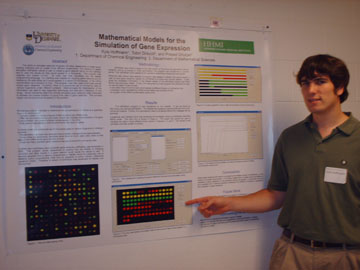 Mathematical Models for the Simulation of Gene Expression Kyle Q. Hoffmann, Tobin A. Driscoll, and Prasad Dhurjati Departments of Chemical Engineering and Mathematical Sciences The ability to simulate
networks of genes will allow researchers to
better study existing networks and to create more efficient
experiments. The existing C based simulation eXPatGen allows a user to
create a gene network via an on-line interface and to view the results
as they would appear in a microarray. This program was repaired and
placed on-line. Its code was then translated into the Matlab
programming language. An interface was created for inputting gene
networks and for displaying the data either as it would appear in a
series of microarrays, or the mRNA concentration as a function of time.
This program was then used to simulate several simple gene networks.
Currently, there is a substantial set of microarray data for various
organisms under different contexts. Methodologies for interpretation of
this information can lead to new diagnostic techniques and also aid in
discovery of new drugs. Some microarray data from simple simulated gene
networks were interpreted to address the inverse problem of going from
data to gene networks. This provided insight into the enormous
complexity of the problem. The Howard Hughes Medical Institute funded
this work.
|
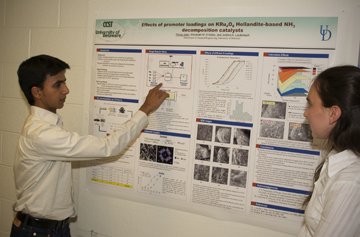 Effects of Promoter Loadings on KRu4O8 Hollandite-based NH3 Decomposition Catalysts Parag Jalan, Elizabeth M. D’Addio, and Jochen A. Lauterbach Department of Chemical Engineering Because of issues associated
with H2 storage, materials with a high H2 density
have been proposed for use in mobile fuel cell applications. Ammonia is
an attractive choice because it can be catalytically decomposed to form
CO-free hydrogen. However, current catalysts require high temperatures
to attain a satisfactory conversion. This challenge necessitates
exploration of novel catalytic materials that will be highly active at
low temperatures for energy efficient ammonia
decomposition. Results of previously conducted experiments
have shown that ruthenium has the highest catalytic activity of all
single metals. A significant increase in its activity is achieved by
promoting the single metal with potassium. A series of unpromoted and
K-promoted Ru catalysts from different precursors was tested using a
home-built single reactor and Fourier Transform Infrared (FTIR)
spectroscopy. Potassium loadings ranging from 0 wt% to 50 wt% were
tested and it was found that the addition of 12 wt% K to 4 wt% Ru
increases the NH3 conversion by 30-50% at temperatures
around 350°C. The high conversion was related to the formation of
KRu4O8 Hollandite “nano-whiskers” on the
K-promoted Ru catalyst. SEM analysis of the catalysts after
calcinations suggests that increased formation of these nano-whiskers
corresponds to higher activity. At this time, the role of the
Hollandite is still under investigation. It is likely that the
Hollandite acts as a structural promoter that decomposes to form a
highly active metallic Ru phase in close proximity to promoting
K. Funded by the University of Delaware’s Undergraduate Research
Program and the Department of Energy.
|
|
Efficiency Improvement for Time-Domain Integral Equation Methods for Electromagnetic Scattering Garret McGraw and Daniel Weile Department of Electrical and Computer Engineering Computational electromagnetics
involve the solving of time or frequency domain forms of Maxwell's
equations to predict the behavior of electromagnetic fields.
While many approaches have been used over the years, one that has
proved most problematic has been solving the integral form of Maxwell's
equations in the time domain. Since the beginning, the
computational nature of the project required a more optimized platform
than the ones traditionally used by engineers such as Matlab or
Labview. For a variety of reasons, including speed, object
orientation, and the availability of programming tools, C++ was chosen.
Now that much of the C++ code has been written and a library of
functions has been established, it became necessary to maintain
and comb through the code, analyzing the methodologies used for basic
parts of the code to ensure that performance was not sacrificed in the
name of clarity. Under this project, the code is bein documented and
made more efficient in anticipation of future practical computations
and research. / Funding was provided through NSF.
|
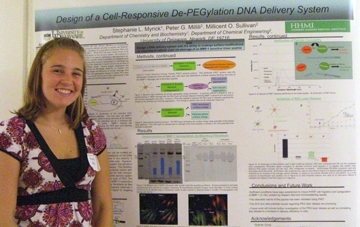 Design of a Cell-Responsive De-PEGylation DNA Delivery System Stephanie L. Myrick, Peter G. Millili, Millicent O. Sullivan Department of Chemical Engineering (Stephanie also presented her work as a talk in the Sigma Xi competition.) We are interested in
formulating non-viral DNA delivery vehicles with
high delivery efficiency by incorporating multiple functional layers
that can be sequentially cleaved off during the delivery process to
expose new features. We have established a simplified single-layered
model vehicle consisting of a polycation-condensed DNA core attached
via a linker peptide to a layer of poly(ethylene) glycol (PEG). While
PEG has been widely shown to be vital in protecting biomaterials from
salt-induced aggregation and attack by the immune system, the presence
of PEG ultimately inhibits DNA delivery at the target cell. This
project is focused on validating a cell-responsive de-PEGylation of the
vehicle prior to delivery via cleavage of the linker peptide, which is
sensitive to proteases such as matrix metalloproteinase-1 (MMP-1).
MMP-1 is a collagen-degrading enzyme upregulated by fibroblasts as they
migrate through the extracellular matrix; such migration is typically
observed in tumor stroma and at sites of injury, making MMP-1 secretion
a useful signal for targeting these areas. Having already established
the conditions that stimulate MMP-1 expression by normal human dermal
fibroblasts (NHDFs) via Western blot analysis and immunofluorescence
staining, we have begun to investigate the efficiency of vehicle
cleavage (and de-PEGylation) by MMP-1 using light scattering in
combination with salt aggregation assays to detect PEG layer release
following vehicle incubation with recombinant MMP-1. Future work will
include further experiments in this area and the investigation of the
transfection efficiencies of PEGylated and dePEGylated particles. This
project is supported by Howard Hughes Medical Institute, National
Science Foundation (CBET-0707583), and the University of Delaware
Research Fund (UDRF).
|
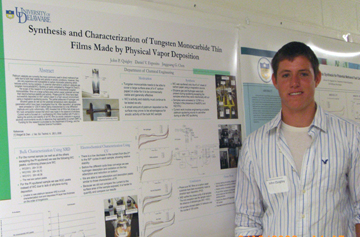 Synthesis and Characterization of Tungsten Monocarbide Thin Films Made by Physical Vapor Deposition John P. Quigley, Daniel V. Esposito and J.G. Chen Department of Chemical Engineering Platinum catalysts are
currently the most commonly used in direct
methanol fuel cells due to both their stability and activity in anodic
conditions. However, they are very expensive and susceptible to carbon
monoxide poisoning which reduces activity during oxidation. A potential
alternative to platinum catalysts are tungsten monocarbide(WC).
Building on work completed by Weigert & Chen[1], the scope of this
research is to synthesize and characterize tungsten monocarbides films
on a large surface area carbon paper substrate and test their
electrochemical stability and activity. Phase-pure WC films have been
successfully deposited on 4x4” carbon paper in a high vacuum
environment using a magnetron sputtering source. The partial pressures
of hydrogen and ethylene gases as well as the substrate temperature
were deposition parameters which have been investigated thus far. After
deposition, all samples were annealed to 1250 K before being
characterized by x-ray diffraction methods and cyclic voltommetry. XRD
revealed that all films had phase pure WC bulk composition except that
which was made in the absence of ethylene. Current work is focused on
i.) synthesizing WC films modified with Pt and ii.) testing the
activity and stability of all WC films as anodic catalysts in aqueous
alcoholic environments ex-situ to determine their applicability to
current DMFC’s. References
[1] Weigert & Chen. J. Vac. Sci. Technol. A. 26(1). 2008. Funding
for this research is provided by the Department of Energy, and the
National Science Foundation.
|
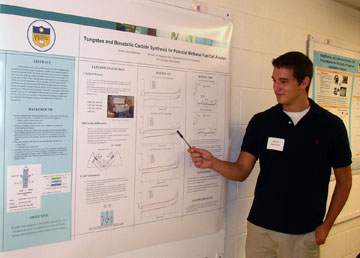 Tungsten Carbides and Bimetallic Carbides as Potential Methanol Fuel Cell Anodes Aaron Reinicker, Jingguang Chen, Zach Mellinger, and Mike Humbert Department of Chemical Engineering In the present work, several
different potential electrocatalysts were
synthesized on carbon paper containing a specific percentage of
tungsten carbide mixed with Pt, Ru, and Ta as a thin film on the
surface. All catalysts were prepared using an incipient wetness
procedure where metallic precursors were dissolved in a solvent and
added drop-wise to Carbon Paper. Then the samples were heated in a
quartz tube furnace under a stream of CH4 and H2.
These catalysts were
characterized by X-ray Diffraction (XRD) and Cyclic Voltammetry (CV) in
a solution of 0.2M methanol/0.5M H2SO4 to
determine their activity to
methanol oxidation. Incipient wetness proved to be a successful
synthesis technique as XRD showed all samples to have the correct
components and atomic ratios. CV tests also showed that 10% WC 10% Pt
on Carbon Paper was the best catalyst for methanol oxidation.
|
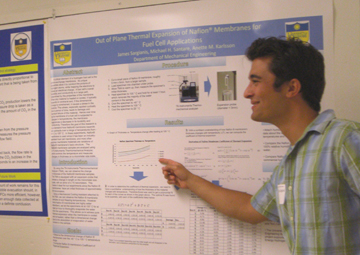 Out of Plane Thermal Expansion of Nafion® Membranes for Fuel Cell Applications James Sargianis, Michael H. Santare, and Anette M. Karlsson Mechanical Engineering Department A critical element of a
hydrogen fuel cell is the proton-exchange
membrane. Its unique properties allow it to conduct the protons of
hydrogen atoms, while trapping the electrons to create an electrical
charge. A fuel cell’s overall durability and conductivity is in large
part, determined by the properties of the membrane. When any material
is heated or cooled, it typically expands or contracts and, if this
dimensional change is constrained, it causes stress in the material.
This stress, especially applied cyclically over a period of time, leads
to damage and eventual failure of the material. Hence over time as the
membrane of a fuel cell is subjected to changes in temperatures, the
membrane experiences a decrease in its durability and conductivity.
Therefore the goal of this research is to understand how Nafion®
membrane expands and contracts over a range of temperatures from
-40° C
to 105° C. In these experiments, Nafion® membrane is used since
it has
been an industry-standard fuel cell membrane, and most other polymer
membrane materials are variations of Nafion® membrane’s basic
structure. The Nafion® membrane samples are analyzed using a TA
Instruments Thermomechanical Analyzer, which controls the temperature
and measures changes in thickness on a micrometer size scale.
|
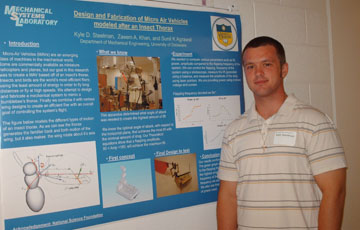 Design and Fabrication of Micro Air Vehicles modeled after an Insect Thorax. Kyle D. Steelman, Zaeem A. Khan, and Sunil K. Agrawal Department of Mechanical Engineering Micro Air Vehicles (MAVs) are
emerging as the focal point for aerial
vehicle research and funding. This project’s goal is optimizing MAV
design and fabrication, based on optimized kinematics, with current
designs being modeled after an insect thorax. With an optimized
mechanical system, we can then expand the project to controlling flight
of the system, thus creating a wide variety of applications. This
research will explain Insect flight, how we mimic that motion, and show
experimental results of our mechanical system.
|
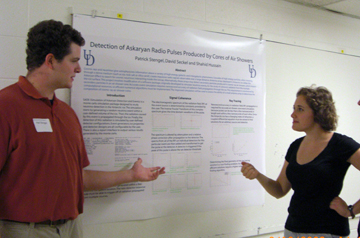 Detection of Askaryan Radio Pulses Produced by Cores of Air Showers Patrick Stengel, David Seckel, and Shahid Hussain Department of Physics and Astronomy Cosmic rays and
neutrinos
give astrophysicists information about a variety of high energy
galactic and
intergalactic phenomena. Cascades of high energy particles, when
traveling
through a dense medium (such as ice, rock salt or silica sand), create
impulsive radio signals observable over a large distance. Antenna
arrays
deployed in Antarctic ice utilize this Askaryan Effect to search for
cosmic
neutrinos interacting inside the icecap. Alternatively, these arrays
may detect
secondary particles produced in cosmic ray air showers, which impact
the ice
surface. This project involves modification of a software package,
originally
developed to simulate neutrino events, for the study of coherent
radiation from
the multiple secondary particles in an air shower core. Accurate event
simulation requires nanosecond accuracy of radiation field propagation
through
the ice. This requirement is constrained by computational resources, so
efficient numerical algorithms must be implemented. The improved
simulation
will be used to assess the ability of a small antenna array to
determine the
composition of cosmic ray air shower cores. |
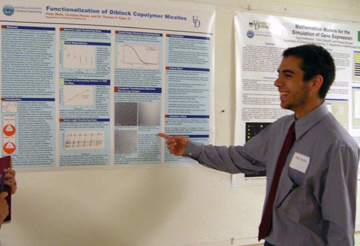 Functionalization of Diblock Copolymer Micelles Peter Wells, Christina Russo, and Thomas H. Epps, III Department of Chemical Engineering Amphiphilic diblock copolymer
micelles have uses as transport agents in
different applications and their efficacy can be increased if they are
functionalized. The specific diblock copolymer system
polybutadiene-b-poly(ethylene oxide) (PB-PEO) was chosen because the
system is biocompatible[1], and the phase behavior has already been
characterized[2]. Solutions of water and tetrahydrofuran (THF)
containing the PB-PEO micelles were characterized using quasi-elastic
light scattering (QLS) and cryogenic transmission electron microscopy
(CryoTEM). For copolymer in pure water, CryoTEM data displayed micelle
sizes of approximately 50 nm, but QLS displayed sizes of approximately
90 nm. Static light scattering (SLS) and small angle neutron scattering
(SANS) experiments were also conducted on the copolymer/water solutions
to resolve the size discrepancy, and the data were in good agreement
with the CryoTEM micrographs. It is believed that the difference in
size is due to the PEO corona causing friction with the solvent,
resulting in slower movement than predicted by the simplified
Einstein-Stokes equation used in QLS. The micelle size disparity also
occurred with the addition of THF to copolymer/water solutions.
However, both QLS and CryoTEM supported the trend of increasing micelle
size with increasing THF volume. It is theorized that some of the PB
chains in the core of the micelle were drawn into the corona (PEO) by
the THF and increased the overall size of the micelle. This gives
opportunity for these micelles to be functionalized by attaching
peptides to the methylene side group on the polybutadiene within the
corona. Funding provided by the University of Delaware Research
Foundation (UDRF).
[1] Savic, R.; Luo, L.; Eisenberg, A.; Maysinger, D., Science 300, 615,
2003. “Micellar nanocontainers distribute to defined cytoplasmic
organelles”
[2] Jain, S.; Gong, X.; Scriven, L. E.; Bates, F., Physical Review
Letters 96, 138304, 2006. “Disordered network state in hydrated
block-copolymer surfactants”
|
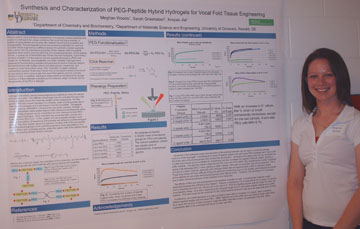 Synthesis and Characterization of PEG-Peptide Hybrid Hydrogels for Vocal Fold Tissue Engineering Meghan Woods1, Sarah Grieshaber2, Xinqiao Jia2 1Department of Chemistry and Biochemistry,2Department of Materials Science and Engineering Material used in vocal fold
tissue engineering must possess several
properties that enable it to withstand the unique conditions that vocal
fold tissue endures. In addition to being flexible and durable, the
material should be biocompatible and biodegradable. Polymer-peptide
hybrids are promising candidates for vocal fold and other tissue
engineering scaffolds because the synthetic polymer segments allow
control over the mechanical properties of the material, while the
peptide segments allow control over the assembly and biological
properties. As the peptide domain, a repeat unit of AKAAAKA was chosen
from the hydrophilic, cross-linking domains of elastin. For the polymer
domain, poly(ethylene glycol) (PEG) was chosen for its flexibility,
biocompatibility, and water solubility. Hydrogels were produced by
functionalizing peptides and polymers of various molecular weights and
architectures with multiple alkyne and azide groups, respectively, and
covalently cross-linking them using “click” chemistry, a
copper-catalyzed cycloaddition reaction. It has been shown that an
increased number of functional groups leads to more viscous gels that
reach their gelation point in a shorter amount of time. In addition,
rheological measurements indicate that the storage modulus of these
materials increases as the molecular weight increases and as the
geometry of the PEG is changed. This project was funded by HHMI.
|
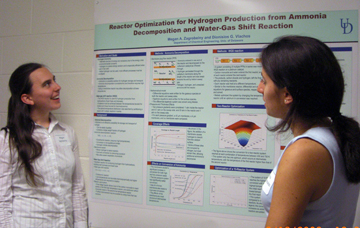 Alternative Reactor Optimization for Hydrogen Production from Ammonia Decomposition and Water-Gas Shift Reaction Megan A. Zagrobelny and Dionisios G. Vlachos Department of Chemical Engineering The continuing environmental
concerns and the recent energy crisis
require a paradigm shift in the production and utilization of energy.
Hydrogen is the greenest fuel, and fuel cells have much higher energy
efficiency than internal combustion engines. Consequently, identifying
efficient ways to produce hydrogen production is important. In this
research, several routes for hydrogen production are being studied with
focus on optimizing the devices (reactors) producing hydrogen. Ammonia
is an attractive option for hydrogen storage and transport; however,
high temperatures are required for decomposition of ammonia. A model
was developed for a membrane reactor for ammonia decomposition over a
ruthenium catalyst. Adding a hydrogen-selective membrane caused
adsorbed hydrogen to be removed from the catalyst surface, thus freeing
active sites and allowing additional ammonia to decompose. The effects
of membrane thickness and pressure gradient across the membrane were
also studied.
The second part of the work conducted focuses on the water-gas shift
reaction that plays an important role in obtaining hydrogen from
hydrocarbons, both from fossil fuels and from biomass. Because the
reaction is exothermic and equilibrium limited, a balance must be
achieved between the thermodynamically favorable low temperatures and
the kinetically necessary high temperatures. One possible solution is
to use multiple reactors that operate at different temperatures. A
system of multiple reactors in series was designed and optimized to
determine the best temperature to operate each reactor. Conversion of
carbon monoxide was improved significantly by using multiple reactors,
with lower temperatures in the later reactors. Acknowledgements: This
work was sponsored in part by the Northeastern Chemical Association and
by the DOE.
|